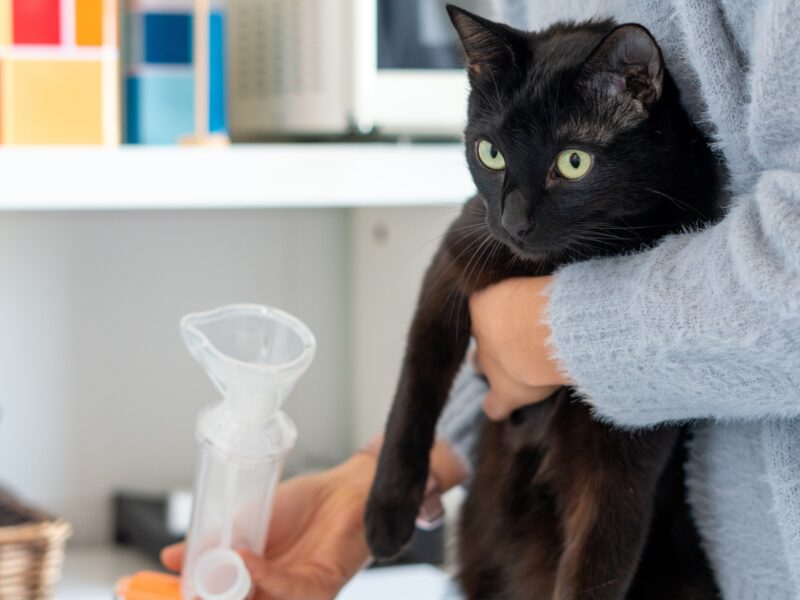How To Successfully Introduce New Cats To Other Pets

Bringing home a new cat can be equally exciting and scary for both resident pets and the new feline family member, especially if friction arises between the animals.
To carefully introduce new cats to the family in a way that encourages a peaceful coexistence, Paula Plummer, a veterinary technician at the Texas A&M School of Veterinary Medicine and Biomedical Sciences, offers owners step-by-step guidance that can help ensure all pets are comfortable every step of the way.
Creating A Safe Space With Privacy
There are generally three steps for introducing cats to pre-existing pets. The first step is to provide a space away from other animals that allows the new cat to become familiar with the new home and new people.
Owners should place their new cat in an isolated safe zone, such as a bedroom or office, where all of their necessities — food, water, litter box, toys, bed, etc. — are available only to them.
“Cats need their own private areas so that they can adjust to their new environment in their own time, but they should also have lots of positive interactions with anyone living in the home to know humans are safe,” Plummer explained. “How long it takes for a cat to adjust is dependent on each cat, and signs that a cat hasn’t adjusted to their safe zone because they are scared, anxious or stressed include hiding, putting distance between what they are scared of and themselves, or trying to escape from their environment.”
Plummer encourages owners to stock the cat’s safe zone with hiding places, heights, toys and items that provide warmth, such as new bedding or blankets.
“Cats naturally want to be elevated to watch over their area, which is why they love cat trees,” Plummer said. “If they are not able to do these things, it can be challenging for them to adjust. Additionally, cats can feel threatened by another animal’s scent, so their belongings should be brand new and not hand-me-downs or items that belonged to another pet.”
Introducing Housemates
Once cats have adjusted to their isolated environment, as evident by them resting, sleeping, and continuously interacting with humans, owners should share items between the new and existing animals.
“Allowing new cats to smell items of other animals — either a favorite toy, towel, or bed — gives them time to adjust to the scent of the other animal before meeting,” Plummer said. “For the same reason, owners will need to give their existing animals items belonging to the new cat.”
Cats who are relaxed around another animal’s belongings can transition into the second step — supervised face-to-face meetings with other resident pets. Since most cats are not leash- or harness-trained, Plummer suggests placing cats in a carrier when introducing them to other animals.
“New cats should be in a carrier so that the cat is still in a safe, protected zone,” Plummer said. “People may want to hold the new animal in their arms but that can be dangerous if the introduction doesn’t go well; they could get scratched or bitten, or the cat may attack the other animal. If the interaction goes positively, owners should increase the amount of time the animals are around each other while keeping the cat in the carrier.”
Signs that the new cat is reacting negatively to existing pets include pressing themselves to the back of the carrier, trying to hunker down and hide, or avoiding eye contact with the other animal.
Transitioning To Cohabitation
When the animals seem comfortable with each other after multiple meetings, owners can begin the third step by letting pets loose together in an open environment during supervised visits. Plummer emphasizes that owners need to be cautious and focused during this stage of interaction to prevent pet injuries, especially in households that include dogs.
“Depending on the size of the dog, the dog can be much bigger than the cat and can cause harm or injury very quickly,” Plummer explained. “Cats can cause harm to other cats as well, so owners should be very cautious and attentive to what is going on in the introduction phase. If they have to step away to attend to something else, owners should separate the pets, revisiting introductory time later.”
After a new cat has left their isolated space and joined the rest of the household, it’s important to take note of the area they identify as their new safe zone so that their belongings can be moved there.
“Cats eventually choose their own private space,” Plummer said. “If owners put bedding in one place but always find their cat sleeping and resting somewhere else, then that’s where the cat has chosen their space to be instead. Just be sure that the same space hasn’t been chosen by another animal so that there is no competition over items, like a bed, litter box, or food bowl.”
Cats may also begin to explore and test boundaries as they become more comfortable in their new home and around other animals, which is why owners should consider additional precautions to keep their cat safe.
“When preparing their home for a cat, especially if this is their first cat, owners should look at their house plants, making sure that they’re cat-friendly and not toxic,” Plummer said. “It’s also important to ‘cat-proof’ your home by ensuring cabinet doors are not easy to open and keeping cleaning supplies out of reach because cats can figure out how to open cabinet doors.”
Every cat is unique, so how they adjust to a new home and the time they take to do so can vary. But by slowly introducing new cats to other pets, owners can ensure that their furry family members foster positive relationships with each other that will last for many years to come.
Media contact: Jennifer Gauntt, jgauntt@cvm.tamu.edu




